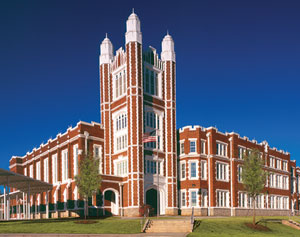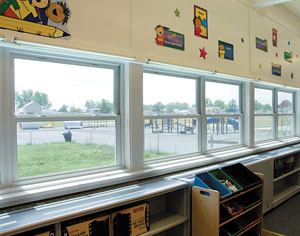Window Replacement Solutions for Commercial and Institutional Buildings
Case Studies
| Carver High School – Atlanta, GA | ||
The historical Carver High School in Atlanta Georgia was recently converted to the New Schools at Carver Early College. The Atlanta Public School system had a mission to combine five schools into one campus in order to establish the first “Early College” of its kind. The combination of college level studies provides many opportunities and the required support for high school students to earn college credit hours in this new, diverse high school environment. These studies include: Technology, Performing Arts, Entrepreneurship and Health / Science Research1. Allain and Associates / Sizemore Group of Atlanta Georgia utilized multiple thermally improved aluminum products to support the historic renovation and create an historic feel in the new construction area of the project. Architectural grade projected windows and fixed double-hung replica products were combined with a custom panning system to recreate the historical profiles and improve thermal capabilities, while enabling completion of the project in ten weeks. |
| West Elementary School, Laurel, MT | ||
About 15 miles southwest of Billings, in Laurel, MT, is West Elementary School. It sits beside a playground on 15 grassy acres and accommodates 350 students in kindergarten through fifth grade. Built in 1956, with an addition in 1979, West Elementary School's original aluminum windows served as more of a hindrance than a help in the learning process for both teachers and students. The old aluminum windows were long overdue for replacement. Noise from the playground distracted the students. Teachers had no control over temperature; it was always either too hot or too cold. The school has no air conditioning, and attempting to open the nonscreened single-pane windows for improved airflow resulted in bugs flying in - including bees that would sting the children. During winter, when average outside temperatures range from 15 to 43 degrees, the extremely drafty old windows cost the school extra money on heating bills. The administration for West Elementary School was looking for a functional window that was durable, energy-efficient and low-maintenance. New replacement double-hung windows were selected for the school made from an engineered fiberglass composite that's more durable than aluminum, offers the thermal efficiency of wood, yet is priced competitively with vinyl. Plus, they do not need to be painted, so there are minimal maintenance costs. Low-E insulating glass improves insulating value, reduces heat gain and offers protection from UV rays, making the windows extremely energy-efficient. The aesthetic goal was to achieve a look that went well with the building construction type. The project didn't start until July, so West Elementary School had only seven weeks to install 165 units before school began. The original windows had supported two-inch-thick glass blocks above. The intent was to cut the window frames, take the windows out for replacement and leave the glass blocks in place. But since they had been mortared to the windows, the glass blocks had to be removed and replaced with steel panels. Since having the new windows installed, the school has noticed a significant decrease in noise from the playground coming into the school, as well as savings in heating costs. Plus, the screens allow more cool air in when needed while keeping bugs out. One administrator commented, "It's hard to learn when the classroom isn't comfortable. We used to get e-mails all the time from teachers saying the rooms were too hot or too cold. Since installing the new windows, we haven't had a single complaint like that." |
| Utilicorp United World Headquarters, Kansas City, MO | ||
When multinational energy company Utilicorp United decided to renovate the former New York Life building in Kansas City, Missouri, for its headquarters, the challenge was to create a workplace that embodies a commitment to energy conservation and to the environment. Wood windows were selected because they enabled the architects to stay true to the Neo-Romanesque design of the building - necessary for its listing on the National Register of Historic Places - while making the proper fenestration contribution to energy efficiency. The solution was Low-E, insulating glass in operable double-hung units that allow natural ventilation, a rare luxury for modern high-rise buildings. The design team made the most of the structure's strengths - like the alignment and shape of the window openings and skylights, which allow abundant daylight to penetrate deep into interior spaces. The building's use of windows makes natural illumination one of its more important energy-saving features. A strong commitment to the environment was also underscored by this solution. Not only do wood windows have excellent insulating properties, wood is also a renewable resource. In sum, the building is the perfect blend of history and technology - re-creating the elegance of the original structure while making use of today's innovations. |
| St. Charles Mercy Hospital, Toledo, OH | ||
Since 1953, St. Charles Mercy Hospital has been providing healthcare to Toledo, OH's eastern communities. St. Charles offers a comprehensive range of inpatient and outpatient care in a homelike setting. When the original metal windows were replaced with aluminum-clad wood windows, the building team chose to use a subframe installation method. For this the aluminum subframe components were pre-assembled and installed into the openings, concealing the existing metal frame, to become a "receptor" for the new window. This method allowed the new windows to be installed from inside the building, minimizing disturbance to existing construction and eliminating the need and expense of exterior scaffolding. In addition, the windows included cordless tilt-only blinds located between the panes of glass where they are protected from dust, damage, and allergens. |
| Walsh University, Canton, OH | ||
Walsh University needed windows that would withstand day-to-day use by college students, match the style of other buildings on campus, and save energy. Located on 85 sprawling acres and surrounded by an abundance of trees, Walsh University is a private college in Canton, Ohio. Alexis and Menard halls were built in 1968 and together house 400 students. The goal for this project was to replace the existing aluminum windows in Alexis Hall and build the Betzler Tower addition onto Menard Hall. The challenge was finding replacement and new construction windows that matched. The windows needed to be extremely durable and low-maintenance to handle use and abuse by college students, as well as to complement the architectural style of the halls and other campus buildings. The windows also had to be affordable and energy-efficient - so the students would have a comfortable living environment and the school would save on its energy costs. Walsh University decided to install new fiberglass composite windows for the new addition on Menard Hall and the Alexis Hall replacement project. Low-E insulating glass was chosen to reduce heat gain and offer protection from UV rays, making the windows extremely energy-efficient. Plus, the brown single-hung windows used for the punched openings and vertical stacks matched the buildings' colors and brought Menard Hall and Alexis Hall up to a standard that's acceptable to the university. Installation of Alexis Hall's replacement windows proved to be a challenge. The 40-year-old, clear anodized aluminum windows had been caulked several times and had a brown aluminum panel at each floor line. The existing windows sat flush with precast floors, complicating the installation of new windows. To ensure optimum installation performance, the window manufacturer developed an innovative installation solution at the spandrel locations to cover the precast slab, seal the windows and prevent joints from showing. Menard Hall's addition required cutting through walls in the existing building to create floors in the new structure. It was a complex project all around - except for the windows. The general contractor said, "We installed them in accordance with the installation shop drawings, and they fit exactly as we needed - we had no issues." |
|














